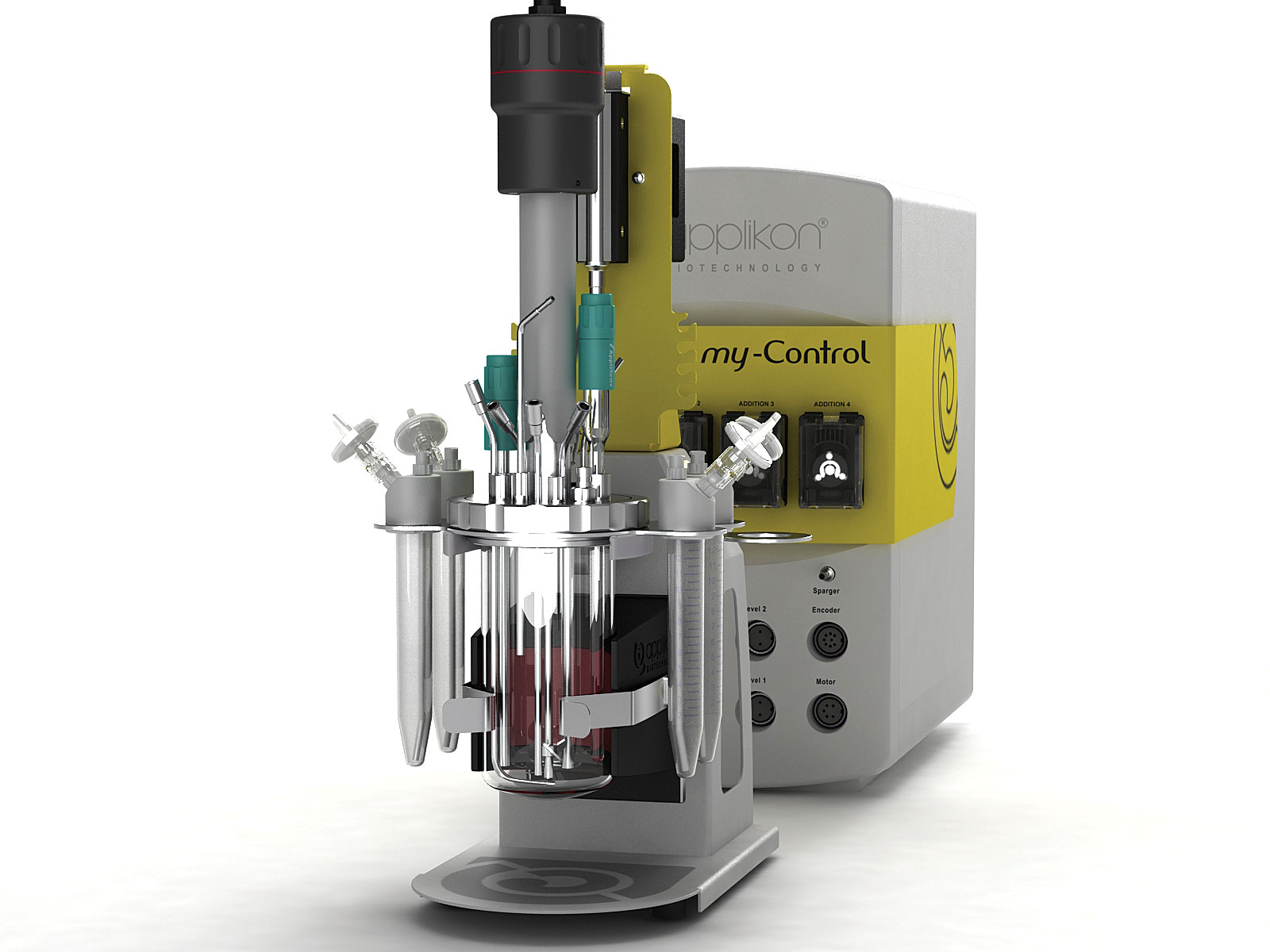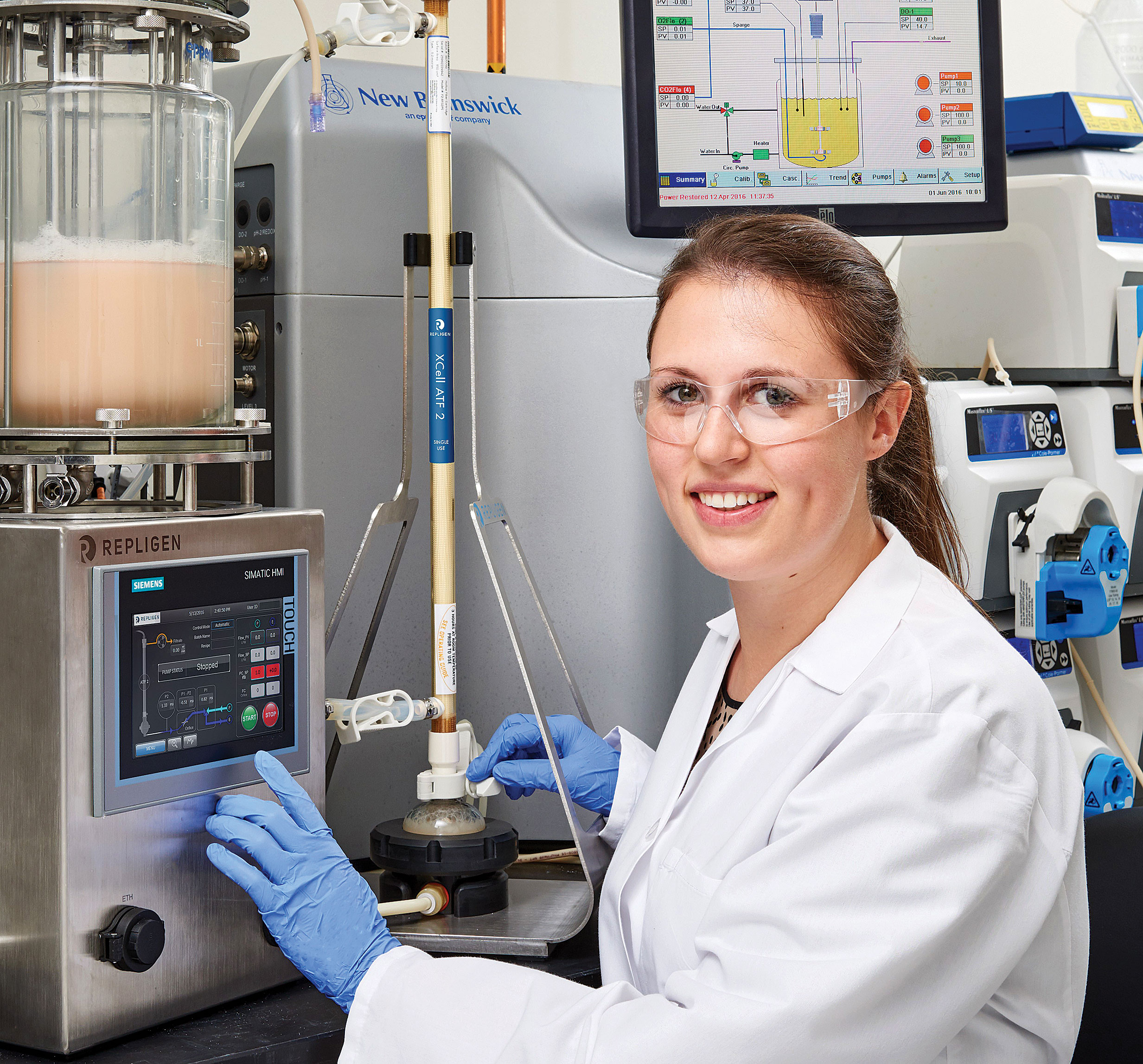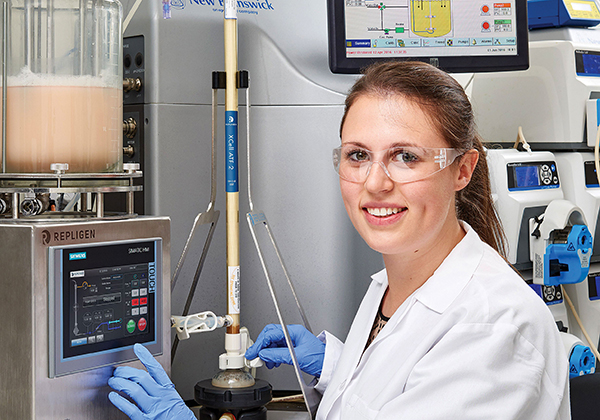August 1, 2017 (Vol. 37, No. 14)
Bench-Scale Bioreactors Incorporate Single-Use Elements, Linearly Scalable Actuators, and Sensors
Bench-scale bioreactors ranging in volume from about 2 L to 20 L have become indispensable as intermediate-scale vessels for process development, scale-down troubleshooting or debottlenecking, generating characterization quantities of protein, and cell culture seed generation. Cultures amenable to benchtop-scale reflect current industry practice: batch, fed-batch, perfusion/continuous cell culture, and the fermentation of microorganisms. Stainless-steel benchtop bioreactors are still around, and single-use systems are gaining, but autoclavable glass see-through bioreactors have become the industry standard.
Industry has settled on three liters as the ideal scale to a significant degree because of its appropriateness for scale-down modeling. This size, in glass, is an offering from Applikon Biotechnology. “But not all mini-scale bioreactors, in the sub-2 L range, are suitable for this purpose,” says John Poppleton, marketing director of the company.
Applikon’s MiniBio reactors range in size from the ubiquitous 3 L benchtop size and microbioreactors in the sub-100 mL size range. Applikon’s autoclavable MiniBio products come in 250 mL, 500 mL, and 1000 mL sizes for 200 mL, 400 mL, and 800 mL working volumes, respectively.
Applikon claims its mini-scale bioreactors are as configurable as benchtop systems. It achieves this level of compatibility and scalability by duplicating the geometric characteristics of 3-L vessels in smaller volumes. “We spend a lot of effort on ensuring and demonstrating scalability,” Poppleton says.
One critical aspect of scalability is duplicating the sensor set at small scale. Advanced sensors are common in multi-liter benchtop bioreactors, in part because bioreactors in that size domain serve as testing platforms. “It’s a good way to get early adoption without facing the regulatory restrictions of manufacturing scale,” says Poppleton. Those sensor technologies that pass muster are then introduced at larger scale, but not always for very small scales because of space constraints.
Applikon is changing this upward adoption pattern by introducing probes that work at both bench- and mini-reactor scale. Their pH sensor and optical dissolved oxygen sensor has a diameter of 8 mm, as opposed to 12 mm for standard probes. Applikon is also working with Buglab on a biomass sensor that fits into their mini bioreactors. “Mini-scale sensors are not as well developed as [they are] for bench scale, but they are catching up,” Poppleton adds.

Applikon’s MiniBio bioreactors, available in a various sizes (250 mL, 500 mL, and 1000 mL total volume), permit accurate scale-down modeling of laboratory-scale processes that may be performed by bioreactors in the 1–15 L range.
Sweet Spot for Process Development
Making the case for performing batch or fed-batch cell culture at bench scale is easy. What about perfusion cell culture, which produces product continuously, sometimes for months? According to John Bonham-Carter, director for upstream sales and business development at Repligen, the very same arguments for batch cultures apply to perfusion-based processes: “Bioreactors of around 3 L in volume are very well understood, and process developers have a great deal of confidence in results at that scale. Three-liter reactors provide almost all of the answers you’re looking for during development or scale down. You can also reach those answers at 50 L, but at vastly higher cost.”
So, given the performance and productivity of perfusion reactors, and if 3 L cultures work so well and save costs relative to larger sizes, why not go even lower than bench scale?
Bonham-Carter explains that smaller sizes, say 250 mL, are not yet as well-characterized as the 3-L scale. “There is much less confidence in predictability [of 250-mL models] with respect to larger scale, particularly in perfusion.”
Three liters also allows for more space for various ports to measure, analyze, and make alterations (addition of nutrients, sampling of fluids, etc.). “These smaller devices provide a good estimate of large-scale work, but you often have some compromises to make,” Bonham-Carter adds. For example, smaller versions have less room for probes and sensors, particularly when experimental spectroscopic probes compete for bioreactor real estate with essential dissolved oxygen and cell-density sensors.
Another reason why perfusion process developers avoid volumes smaller than about 3 L is that cell-retention devices are hard to come by for reactor volumes lower than 2 L. “Below that, you’re seeing mostly homebrew or unscalable systems. Standardization of cell-retention devices at very small scale hasn’t yet occurred,” Bonham-Carter says.
One small-volume cell-retention device, the spin filter, uses a rotating sieve to harvest cell-free protein. Product generated within the reactor is drawn through a high pore size membrane to an inner harvest compartment. Spin filters have been around for years and many vendors sell them. But spin filters are not good scale-down models and do not support high cell density, since no large processes use them. Similarly, devices that rely on cell settling and harvest from supernatants have no counterpart above about 500 L.
“The reason you don’t see perfusion reactors below 2 L or so in volume is not because people don’t want them, but because a scalable robust device hasn’t been proven yet,” Bonham-Carter explains.
Interestingly, bench scale is the earliest development stage where perfusion cell culture reliably mimics performance at pilot or manufacturing scale. Therefore, it is the point at which decisions to go batch or continuous are made. This is, in part, due to the lack of scalability for most perfusion cell culture systems to volumes below 2–3 L.
Therefore, even processes that eventually employ perfusion cell culture begin with—and learn from—batch or fed-batch culture. “If the intention is to go continuous, then the process development plan will be shaped thereafter toward that goal,” says Annelies Onraedt, marketing director for cell-culture technologies at Pall Life Sciences.

Repligen’s benchtop single-use XCell™ ATF 2 cell-retention device is shown here in operation with a small bioreactor. The XCell ATF system uses alternating tangential-flow (ATF) technology for cell retention and process intensification.
Materials of Construction
While maintaining vessel geometry, agitation, gassing, and form factor among scales lessens the uncertainties in scaling from microscale to benchtop to production, another factor—materials—comes into play with the wide adoption of single-use bioreactors.
The need for benchtop or smaller versions of larger single-use bioreactors encompasses a desire for equivalent product contact surfaces, according to Ken Clapp, senior manager for applications, technology and integration at GE Healthcare (Marlborough, MA). “Material compatibility should be a foremost consideration.” Quality parameters can only be assumed when the vessel’s leachables and extractables profiles are themselves comparable. Suppliers should be ready to assist in this regard.
GE’s Xcellerex XDR line of bench-scale bioreactors achieve this by using the same polymer family for the process-contacting bag film as GE uses in all its larger single-use bioreactors. “This allows us to establish whether cells have problems with the polymer early enough in development to make appropriate changes,” Clapp says. “You don’t get that information by jumping from 10-L glass or rigid plastic bioreactors to 50-L plastic single-use systems. Discovering at that stage that you have cell compatibility or product quality issues is costly.”
By now, the value of bench-scale bioreactors duplicating the form factors of larger reactors is well appreciated on several levels, including the impact of probes on mixing. “Probes coming in through the headspace create a baffling effect unlike the larger bioreactors, so mixing is different than when they come in through the side,” Clapp adds. “There will be enough variables associated with media and volume differences, so it’s important to limit the number of controllable differences between scales whenever possible.”
While extractables profiles may differ between benchtop and production scales due to the greater pliability of large surfaces, Clapp says these factors can be minimized using bag-based, smaller-scale systems. The higher surface-area-to-volume ratio provides sufficient information to know what to look for at larger scale.
Clapp notes that while current molded single-use benchtop bioreactors replicate the geometry of larger systems, they may not use the same polymer types. “By running reactions in different polymers, you’re setting yourself up to perform time-consuming cytotoxicity and leachables [and] extractables studies not once, but twice or more.”
While the economics of single-use are well established above the bench scale, they are not as straightforward for benchtop bioreactors, particularly on the basis of cost of goods. Clapp dismisses these considerations. “We’re talking about high-value products destined for manufacturing, not basic R&D. Single-use equipment is already commonplace at production scale. Companies that work within that framework from the beginning will find that the benefits far outweigh the costs.”
Scaling = Controls
Finesse, a business unit of Thermo Fisher Scientific, known for its bioreactor sensors and controllers, also makes a full range of bioreactors. These include the SmartRocker rocker-type bioreactors up to 50 L, glass vessels ranging from 1 L to 15 L, and a single-use 3-L bioreactor. Single-use sizes of 1 L and 15 L are expected in early 2018.
In designing its benchtop glass bioreactors, Finesse looked at the competition and concluded that obtaining low shear and high kLa in a small bioreactor required a hybrid between Rushton and marine impellers.
According to the company, Finesse bench-scale bioreactors provide full scalability to any of its competitors’ large single-use bioreactors. The company achieved this by duplicating key process actuators that apply to all bioreactors, independent of scale.
“If you use the right control strategy, all the actuators (such as pumps, mass flow controllers, etc.) are linearly scalable, and all the sensors are the same technology (electrochemical or single use), you can, in fact, scale cultures up and down once you’ve determined the kLa, power number, and other key bioreactor process numbers,” says Barbara Paldus, Ph.D., vice president and general manager at Finesse. “Once you define how to scale the key parameters and program them into the controller, it works almost like a mathematical transfer function, from small scale to large scale and back again.”
Subsequently, Finesse noticed that none of the small-volume single-use bioreactor systems on the market resembled their glass counterparts of similar volume, or the larger single-use systems they scale into.
So, once the glass design and scalability models into larger single-use bioreactors were in place, Finesse copied the glass-vessel geometry into the single-use vessel design. “They look identical except one is made of plastic, the other from glass or stainless steel,” Dr. Paldus explains. “We were then able to use electrochemical sensors through top ports, or single-use sensors from the side, or mix and match them as appropriate. Then we tried to match the headplates of the single-use vessels with the headplate of the glass, so users still had four sensor ports available.”
Moreover, the single-use sensors are identical at 3-L, 15-L, or 500-L scale, and behave exactly the same whether in a rocker, glass, or plastic. The linearity and scalability of the pumps, mass-flow controllers, and transmitters remain the same as well. Any components that change in physical size are linearly scalable; and all transmitters are identical, so there’s no controller-to-controller variability.
“Scalability boils down to bioreactor design parameters themselves,” Dr. Paldus explains. “And there, we’ve done computational fluid dynamics to understand the differences and tolerances, which you can use to create control loop parameter mapping, which allows you to go from 3L in our bioreactors to full-scale production from any manufacturer. Once you have all that data, and know the control and measurement components are identical, you’ve reduced the variability in scale up, which is where you find the most problems.”
Sartorius Stedim Biotech’s 2nd-Generation STR Bioreactors
Earlier this year, Sartorius Stedim Biotech (SSB) launched its next-generation Biostat STR®, a fully scalable, single-use bioreactor family based on a conventional stirred-tank design. SSB officials say the new bioreactor range features upgraded hardware and software, as well as a fully integrated, new design of Flexsafe STR® single-use bags.
The original Biostat STR was introduced to the market in 2008 and has since served as the single-use production platform at a number of major pharma companies, according to Thorsten Adams, Dr. rer. nat., director of product management, fermentation technologies, at SSB.
“Working closely together with our customers, we have incorporated our combined experience to introduce design optimizations to increase robustness and flexibility,” he said. “The operator experience has been enhanced by making bag installations even easier. The new Flexsafe STR bags provide robustness, consistent cell growth, and control of raw materials.”
Dr. Adams explained that the bioreactors seamlessly integrate into the customer infrastructure while simultaneously showing significantly improved heating and cooling times due to optimized double-wall geometries. The control system integrates into an existing distributed control systems (DCS) infrastructure, he added.
The systems are completely scalable and the single-use bioreactors possess the same geometries as small-scale process-development systems and stainless-steel bioreactors, continued Dr. Adams.
“This means that critical process parameters (CPP) can easily be scaled up,” he pointed out. “The need of running optimizations at target production scale is dramatically reduced.”

Sartorius Stedim Biotech recently launched the Biostat STR family, a range of next-generation bioreactors. The bioreactors, which feature upgraded hardware and software, work with Flexsafe STR single-use bags to facilitate the scale-up of bioprocesses for biologics and vaccines.



